I frequently need to create geographical heat maps in R. Currently, I have been doing it in a licensed version of Tableau in my office computer which does a superb job. But I need to learn how to do it when I'm out of office. The data is sometimes confidential, so I cannot use Tableau public over the internet. I looked but could not find any solution that produces the result I need.
The data consists of names of districts in the state of Jharkhand, India along with child population in age group 6 to 14 in thousands. In Tableau, I merely have to set the DISTNAME column to "Geographical Role" at "County" level and it pulls the map of the state along with district boundaries from the internet (OpenStreetMap) and produces a heat map like this which is the result I expect from R, if possible:
The data is:
geo_data <- structure(list(DISTNAME = c("BOKARO", "CHATRA", "DEOGHAR", "DHANBAD",
"DUMKA", "GARHWA", "GIRIDIH", "GODDA", "GUMLA", "HAZARIBAGH",
"JAMTARA", "KHUNTI", "KODARMA", "LATEHAR", "LOHARDAGA", "PAKUR",
"PALAMU", "PASHCHIMI SINGHBHUM", "PURBI SINGHBHUM", "RAMGARH",
"RANCHI", "SAHIBGANJ", "SARAIKELA-KHARSAWAN", "SIMDEGA"), POP = c(521.5,
196.5, 323.8, 445.5, 123, 373.9, 357.6, 248.2, 212.4, 686.7,
626.7, 383.6, 391.9, 141, 436.1, 454.6, 301.3, 325.5, 193.7,
238.3, 208.7, 587.4, 130.1, 268)), .Names = c("DISTNAME", "POP"
), row.names = c(NA, 24L), class = "data.frame")
And looks like:
DISTNAME POP
1 BOKARO 521.5
2 CHATRA 196.5
3 DEOGHAR 323.8
4 DHANBAD 445.5
5 DUMKA 123.0
6 GARHWA 373.9
7 GIRIDIH 357.6
8 GODDA 248.2
9 GUMLA 212.4
10 HAZARIBAGH 686.7
11 JAMTARA 626.7
12 KHUNTI 383.6
13 KODARMA 391.9
14 LATEHAR 141.0
15 LOHARDAGA 436.1
16 PAKUR 454.6
17 PALAMU 301.3
18 PASHCHIMI SINGHBHUM 325.5
19 PURBI SINGHBHUM 193.7
20 RAMGARH 238.3
21 RANCHI 208.7
22 SAHIBGANJ 587.4
23 SARAIKELA-KHARSAWAN 130.1
24 SIMDEGA 268.0


